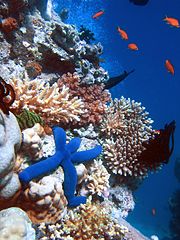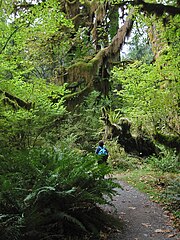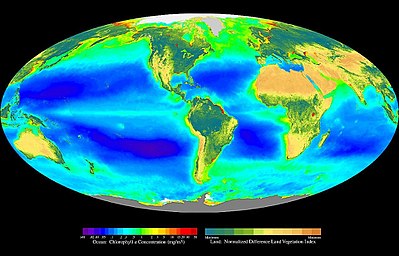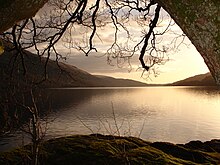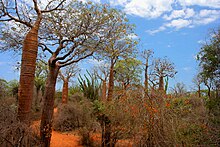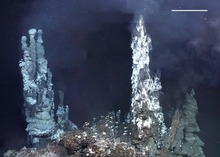Top: Coral reef ecosystems are highly productive marine systems, bottom: Temperate rainforest on the Olympic Peninsula in Washington state.
Ecosystems are controlled by external and internal factors. External factors such as climate, parent material which forms the soil and topography, control the overall structure of an ecosystem but are not themselves influenced by the ecosystem. Unlike external factors, internal factors are controlled, for example, decomposition, root competition, shading, disturbance, succession, and the types of species present.
Ecosystems are dynamic entities—they are subject to periodic disturbances and are in the process of recovering from some past disturbance. Ecosystems in similar environments that are located in different parts of the world can end up doing things very differently simply because they have different pools of species present. Internal factors not only control ecosystem processes but are also controlled by them and are often subject to feedback loops.
Resource inputs are generally controlled by external processes like climate and parent material. Resource availability within the ecosystem is controlled by internal factors like decomposition, root competition or shading. Although humans operate within ecosystems, their cumulative effects are large enough to influence external factors like climate.
Biodiversity affects ecosystem functioning, as do the processes of disturbance and succession. Ecosystems provide a variety of goods and services upon which people depend.
History
The term ecosystem was first used in 1935 in a publication by British ecologist Arthur Tansley. Tansley devised the concept to draw attention to the importance of transfers of materials between organisms and their environment. He later refined the term, describing it as "The whole system, ... including not only the organism-complex, but also the whole complex of physical factors forming what we call the environment". Tansley regarded ecosystems not simply as natural units, but as "mental isolates". Tansley later defined the spatial extent of ecosystems using the term ecotope.G. Evelyn Hutchinson, a limnologist who was a contemporary of Tansley's, combined Charles Elton's ideas about trophic ecology with those of Russian geochemist Vladimir Vernadsky. As a result, he suggested that mineral nutrient availability in a lake limited algal production. This would, in turn, limit the abundance of animals that feed on algae. Raymond Lindeman took these ideas further to suggest that the flow of energy through a lake was the primary driver of the ecosystem. Hutchinson's students, brothers Howard T. Odum and Eugene P. Odum, further developed a "systems approach" to the study of ecosystems. This allowed them to study the flow of energy and material through ecological systems.
Processes
Rainforest ecosystems are rich in biodiversity. This is the Gambia River in Senegal's Niokolo-Koba National Park.
Biomes of the world
Ecosystems are controlled both by external and internal factors.
External factors, also called state factors, control the overall
structure of an ecosystem and the way things work within it, but are not
themselves influenced by the ecosystem. The most important of these is climate. Climate determines the biome
in which the ecosystem is embedded. Rainfall patterns and seasonal
temperatures influence photosynthesis and thereby determine the amount
of water and energy available to the ecosystem.
Parent material determines the nature of the soil in an ecosystem, and influences the supply of mineral nutrients. Topography also controls ecosystem processes by affecting things like microclimate,
soil development and the movement of water through a system. For
example, ecosystems can be quite different if situated in a small
depression on the landscape, versus one present on an adjacent steep
hillside.
Other external factors that play an important role in ecosystem functioning include time and potential biota.
Similarly, the set of organisms that can potentially be present in an
area can also significantly affect ecosystems. Ecosystems in similar
environments that are located in different parts of the world can end up
doing things very differently simply because they have different pools
of species present. The introduction of non-native species can cause substantial shifts in ecosystem function.
Unlike external factors, internal factors in ecosystems not only
control ecosystem processes but are also controlled by them.
Consequently, they are often subject to feedback loops. While the resource
inputs are generally controlled by external processes like climate and
parent material, the availability of these resources within the
ecosystem is controlled by internal factors like decomposition, root
competition or shading. Other factors like disturbance, succession or the types of species present are also internal factors.
Primary production
Global oceanic and terrestrial phototroph abundance, from September 1997 to August 2000. As an estimate of autotroph biomass, it is only a rough indicator of primary production potential and not an actual estimate of it.
Primary production is the production of organic matter from inorganic carbon sources. This mainly occurs through photosynthesis.
The energy incorporated through this process supports life on earth,
while the carbon makes up much of the organic matter in living and dead
biomass, soil carbon and fossil fuels. It also drives the carbon cycle, which influences global climate via the greenhouse effect.
Through the process of photosynthesis, plants capture energy from light and use it to combine carbon dioxide and water to produce carbohydrates and oxygen. The photosynthesis carried out by all the plants in an ecosystem is called the gross primary production (GPP). About half of the GPP is consumed in plant respiration. The remainder, that portion of GPP that is not used up by respiration, is known as the net primary production (NPP).
Total photosynthesis is limited by a range of environmental factors.
These include the amount of light available, the amount of leaf
area a plant has to capture light (shading by other plants is a major
limitation of photosynthesis), rate at which carbon dioxide can be
supplied to the chloroplasts to support photosynthesis, the availability of water, and the availability of suitable temperatures for carrying out photosynthesis.
Energy flow
Energy and carbon enter ecosystems through photosynthesis,
are incorporated into living tissue, transferred to other organisms
that feed on the living and dead plant matter, and eventually released
through respiration.
The carbon and energy incorporated into plant tissues (net
primary production) is either consumed by animals while the plant is
alive, or it remains uneaten when the plant tissue dies and becomes detritus. In terrestrial ecosystems, roughly 90% of the net primary production ends up being broken down by decomposers.
The remainder is either consumed by animals while still alive and
enters the plant-based trophic system, or it is consumed after it has
died, and enters the detritus-based trophic system.
In aquatic systems, the proportion of plant biomass that gets consumed by herbivores is much higher.
In trophic systems photosynthetic organisms are the primary producers.
The organisms that consume their tissues are called primary consumers or
secondary producers—herbivores. Organisms which feed on microbes (bacteria and fungi) are termed microbivores. Animals that feed on primary consumers—carnivores—are secondary consumers. Each of these constitutes a trophic level.
The sequence of consumption—from plant to herbivore, to carnivore—forms a food chain.
Real systems are much more complex than this—organisms will generally
feed on more than one form of food, and may feed at more than one
trophic level. Carnivores may capture some prey which is part of a
plant-based trophic system and others that are part of a detritus-based
trophic system (a bird that feeds both on herbivorous grasshoppers and
earthworms, which consume detritus). Real systems, with all these
complexities, form food webs rather than food chains.
The food chain usually consists of five levels of consumption which are
producers, primary consumers, secondary consumers, tertiary consumers,
and decomposers.
Decomposition
The carbon and nutrients in dead organic matter are broken down by a group of processes known as decomposition.
This releases nutrients that can then be re-used for plant and
microbial production and returns carbon dioxide to the atmosphere (or
water) where it can be used for photosynthesis.
In the absence of decomposition, the dead organic matter would
accumulate in an ecosystem, and nutrients and atmospheric carbon dioxide
would be depleted. Approximately 90% of terrestrial net primary production goes directly from plant to decomposer.
Decomposition processes can be separated into three categories—leaching,
fragmentation and chemical alteration of dead material. As water moves
through dead organic matter, it dissolves and carries with it the
water-soluble components. These are then taken up by organisms in the
soil, react with mineral soil, or are transported beyond the confines of
the ecosystem (and are considered lost to it). Newly shed leaves and newly dead animals have high concentrations of water-soluble components and include sugars, amino acids and mineral nutrients. Leaching is more important in wet environments and much less important in dry ones.
Fragmentation processes break organic material into smaller
pieces, exposing new surfaces for colonization by microbes. Freshly shed
leaf litter may be inaccessible due to an outer layer of cuticle or bark, and cell contents are protected by a cell wall. Newly dead animals may be covered by an exoskeleton. Fragmentation processes, which break through these protective layers, accelerate the rate of microbial decomposition. Animals fragment detritus as they hunt for food, as does passage through the gut. Freeze-thaw cycles and cycles of wetting and drying also fragment dead material.
The chemical alteration of the dead organic matter is primarily achieved through bacterial and fungal action. Fungal hyphae
produces enzymes that can break through the tough outer structures
surrounding dead plant material. They also produce enzymes which break
down lignin,
which allows them access to both cell contents and the nitrogen in the
lignin. Fungi can transfer carbon and nitrogen through their hyphal
networks and thus, unlike bacteria, are not dependent solely on locally
available resources.
Decomposition rates vary among ecosystems.
The rate of decomposition is governed by three sets of factors—the
physical environment (temperature, moisture, and soil properties), the
quantity and quality of the dead material available to decomposers, and
the nature of the microbial community itself.
Temperature controls the rate of microbial respiration; the higher the
temperature, the faster the microbial decomposition occurs. It also
affects soil moisture, which slows microbial growth and reduces
leaching. Freeze-thaw cycles also affect decomposition—freezing
temperatures kill soil microorganisms, which allows leaching to play a
more important role in moving nutrients around. This can be especially
important as the soil thaws in the spring, creating a pulse of nutrients
which become available.
Decomposition rates are low under very wet or very dry
conditions. Decomposition rates are highest in wet, moist conditions
with adequate levels of oxygen. Wet soils tend to become deficient in
oxygen (this is especially true in wetlands),
which slows microbial growth. In dry soils, decomposition slows as
well, but bacteria continue to grow (albeit at a slower rate) even after
soils become too dry to support plant growth.
Nutrient cycling
Biological nitrogen cycling
Ecosystems continually exchange energy and carbon with the wider environment.
Mineral nutrients, on the other hand, are mostly cycled back and forth
between plants, animals, microbes and the soil. Most nitrogen enters
ecosystems through biological nitrogen fixation, is deposited through precipitation, dust, gases or is applied as fertilizer.
Since most terrestrial ecosystems are nitrogen-limited, nitrogen cycling is an important control on ecosystem production.
Until modern times, nitrogen fixation was the major source of nitrogen for ecosystems. Nitrogen-fixing bacteria either live symbiotically
with plants or live freely in the soil. The energetic cost is high for
plants that support nitrogen-fixing symbionts—as much as 25% of gross
primary production when measured in controlled conditions. Many members
of the legume plant family support nitrogen-fixing symbionts. Some cyanobacteria are also capable of nitrogen fixation. These are phototrophs,
which carry out photosynthesis. Like other nitrogen-fixing bacteria,
they can either be free-living or have symbiotic relationships with
plants. Other sources of nitrogen include acid deposition produced through the combustion of fossil fuels, ammonia gas which evaporates from agricultural fields which have had fertilizers applied to them, and dust. Anthropogenic nitrogen inputs account for about 80% of all nitrogen fluxes in ecosystems.
When plant tissues are shed or are eaten, the nitrogen in those
tissues becomes available to animals and microbes. Microbial
decomposition releases nitrogen compounds from dead organic matter in
the soil, where plants, fungi, and bacteria compete for it. Some soil
bacteria use organic nitrogen-containing compounds as a source of
carbon, and release ammonium ions into the soil. This process is known as nitrogen mineralization. Others convert ammonium to nitrite and nitrate ions, a process known as nitrification. Nitric oxide and nitrous oxide are also produced during nitrification. Under nitrogen-rich and oxygen-poor conditions, nitrates and nitrites are converted to nitrogen gas, a process known as denitrification.
Other important nutrients include phosphorus, sulfur, calcium, potassium, magnesium and manganese. Phosphorus enters ecosystems through weathering.
As ecosystems age this supply diminishes, making phosphorus-limitation
more common in older landscapes (especially in the tropics).
Calcium and sulfur are also produced by weathering, but acid deposition
is an important source of sulfur in many ecosystems. Although magnesium
and manganese are produced by weathering, exchanges between soil
organic matter and living cells account for a significant portion of
ecosystem fluxes. Potassium is primarily cycled between living cells and
soil organic matter.
Function and biodiversity
Loch Lomond in Scotland
forms a relatively isolated ecosystem. The fish community of this lake
has remained stable over a long period until a number of introductions in the 1970s restructured its food web.
Spiny forest at Ifaty, Madagascar, featuring various Adansonia (baobab) species, Alluaudia procera (Madagascar ocotillo) and other vegetation.
Biodiversity plays an important role in ecosystem functioning.
The reason for this is that ecosystem processes are driven by the
number of species in an ecosystem, the exact nature of each individual
species, and the relative abundance organisms within these species.
Ecosystem processes are broad generalizations that actually take place
through the actions of individual organisms. The nature of the
organisms—the species, functional groups
and trophic levels to which they belong—dictates the sorts of actions
these individuals are capable of carrying out and the relative
efficiency with which they do so.
Ecological theory suggests that in order to coexist, species must have some level of limiting similarity—they must be different from one another in some fundamental way, otherwise one species would competitively exclude the other.
Despite this, the cumulative effect of additional species in an
ecosystem is not linear—additional species may enhance nitrogen
retention, for example, but beyond some level of species richness,
additional species may have little additive effect.
The addition (or loss) of species that are ecologically similar
to those already present in an ecosystem tends to only have a small
effect on ecosystem function. Ecologically distinct species, on the
other hand, have a much larger effect. Similarly, dominant species have a
large effect on ecosystem function, while rare species tend to have a
small effect. Keystone species tend to have an effect on ecosystem function that is disproportionate to their abundance in an ecosystem. Similarly, an ecosystem engineer is any organism that creates, significantly modifies, maintains or destroys a habitat.
Dynamics
Ecosystems are dynamic entities. They are subject to periodic
disturbances and are in the process of recovering from some past
disturbance. When a perturbation
occurs, an ecosystem responds by moving away from its initial state.
The tendency of an ecosystem to remain close to its equilibrium state,
despite that disturbance, is termed its resistance. On the other hand, the speed with which it returns to its initial state after disturbance is called it's resilience. Time plays a role in the development of soil from bare rock and the recovery of a community from disturbance.
From one year to another, ecosystems experience variation in
their biotic and abiotic environments. A drought, a colder than usual
winter, and a pest outbreak all are short-term variability in
environmental conditions. Animal populations vary from year to year,
building up during resource-rich periods and crashing as they overshoot
their food supply. These changes play out in changes in net primary production decomposition rates, and other ecosystem processes.
Longer-term changes also shape ecosystem processes—the forests of
eastern North America still show legacies of cultivation which ceased
200 years ago, while methane production in eastern Siberian lakes is controlled by organic matter which accumulated during the Pleistocene.
Disturbance also plays an important role in ecological processes. F. Stuart Chapin
and coauthors define disturbance as "a relatively discrete event in
time and space that alters the structure of populations, communities,
and ecosystems and causes changes in resources availability or the
physical environment".
This can range from tree falls and insect outbreaks to hurricanes and
wildfires to volcanic eruptions. Such disturbances can cause large
changes in plant, animal and microbe populations, as well as soil
organic matter content. Disturbance is followed by succession, a "directional change in ecosystem structure and functioning resulting from biotically driven changes in resources supply."
The frequency and severity of disturbance determine the way it
affects ecosystem function. A major disturbance like a volcanic eruption
or glacial
advance and retreat leave behind soils that lack plants, animals or
organic matter. Ecosystems that experience such disturbances undergo primary succession. A less severe disturbance like forest fires, hurricanes or cultivation result in secondary succession and a faster recovery. More severe disturbance and more frequent disturbance result in longer recovery times.
Clear boundaries make lakes convenient to study using an ecosystem approach.
Ecosystem ecology
A hydrothermal vent is an ecosystem on the ocean floor. (The scale bar is 1 m.)
Ecosystem ecology studies the processes and dynamics of ecosystems,
and the way the flow of matter and energy through them structures
natural systems. The study of ecosystems can cover 10 orders of magnitude, from the surface layers of rocks to the surface of the planet.
There is no single definition of what constitutes an ecosystem.
German ecologist Ernst-Detlef Schulze and coauthors defined an
ecosystem as an area which is "uniform regarding the biological
turnover, and contains all the fluxes above and below the ground area
under consideration." They explicitly reject Gene Likens' use of entire river catchments as "too wide a demarcation" to be a single ecosystem, given the level of heterogeneity within such an area. Other authors have suggested that an ecosystem can encompass a much larger area, even the whole planet.
Schulze and coauthors also rejected the idea that a single rotting log
could be studied as an ecosystem because the size of the flows between
the log and its surroundings are too large, relative to the proportion
cycles within the log.
Philosopher of science Mark Sagoff considers the failure to define "the
kind of object it studies" to be an obstacle to the development of
theory in ecosystem ecology.
Ecosystems can be studied through a variety of
approaches—theoretical studies, studies monitoring specific ecosystems
over long periods of time, those that look at differences between
ecosystems to elucidate how they work and direct manipulative
experimentation. Studies can be carried out at a variety of scales, ranging from whole-ecosystem studies to studying microcosms or mesocosms (simplified representations of ecosystems). American ecologist Stephen R. Carpenter
has argued that microcosm experiments can be "irrelevant and
diversionary" if they are not carried out in conjunction with field
studies done at the ecosystem scale. Microcosm experiments often fail to
accurately predict ecosystem-level dynamics.
The Hubbard Brook Ecosystem Study started in 1963 to study the White Mountains in New Hampshire. It was the first successful attempt to study an entire watershed as an ecosystem. The study used stream chemistry as a means of monitoring ecosystem properties, and developed a detailed biogeochemical model of the ecosystem. Long-term research at the site led to the discovery of acid rain in North America in 1972. Researchers documented the depletion of soil cations (especially calcium) over the next several decades.
Human activities
Human activities are important in almost all ecosystems. Although
humans exist and operate within ecosystems, their cumulative effects are
large enough to influence external factors like climate.
Ecosystem goods and services
The High Peaks Wilderness Area in the 6,000,000-acre (2,400,000 ha) Adirondack Park is an example of a diverse ecosystem.
Ecosystems provide a variety of goods and services upon which people depend.
Ecosystem goods include the "tangible, material products" of ecosystem
processes such as food, construction material, medicinal plants. They also include less tangible items like tourism and recreation, and genes from wild plants and animals that can be used to improve domestic species.
Ecosystem services, on the other hand, are generally "improvements in the condition or location of things of value".
These include things like the maintenance of hydrological cycles,
cleaning air and water, the maintenance of oxygen in the atmosphere,
crop pollination and even things like beauty, inspiration and opportunities for research.
While material from the ecosystem had traditionally been recognized as
being the basis for things of economic value, ecosystem services tend to
be taken for granted.
Ecosystem management
When natural resource management is applied to whole ecosystems, rather than single species, it is termed ecosystem management. Although definitions of ecosystem management abound, there is a common set of principles which underlie these definitions. A fundamental principle is the long-term sustainability of the production of goods and services by the ecosystem; "intergenerational sustainability [is] a precondition for management, not an afterthought".
While ecosystem management can be used as part of a plan for wilderness conservation, it can also be used in intensively managed ecosystems.
Threats caused by humans
As human population and per capita consumption grow, so do the
resource demands imposed on ecosystems and the effects of the human ecological footprint. Natural resources are vulnerable and limited. The environmental impacts of anthropogenic actions are becoming more apparent. Problems for all ecosystems include: environmental pollution, climate change and biodiversity loss. For terrestrial ecosystems further threats include air pollution, soil degradation, and deforestation. For aquatic ecosystems threats include also unsustainable exploitation of marine resources (for example overfishing of certain species), marine pollution, microplastics pollution, water pollution, the warming of oceans, and building on coastal areas.
Society is increasingly becoming aware that ecosystem services are not only limited but also that they are threatened by human activities. The need to better consider long-term ecosystem health
and its role in enabling human habitation and economic activity is
urgent. To help inform decision-makers, many ecosystem services are
being assigned economic values, often based on the cost of replacement
with anthropogenic alternatives. The ongoing challenge of prescribing
economic value to nature, for example through biodiversity banking, is prompting transdisciplinary shifts in how we recognize and manage the environment, social responsibility, business opportunities, and our future as a species.
